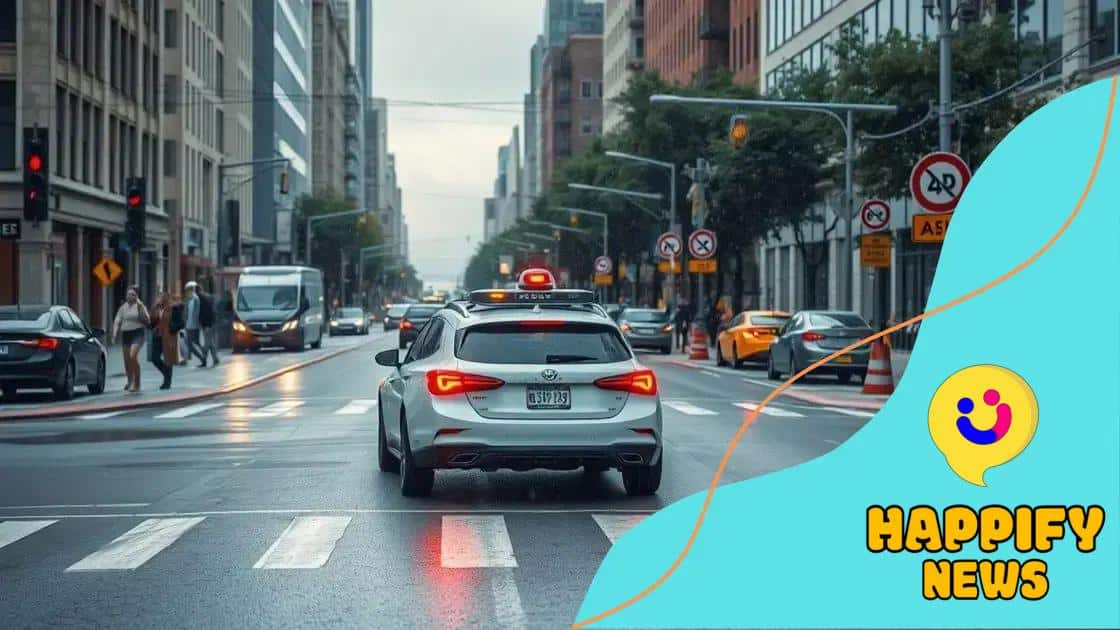Autonomous vehicles reshaping transport: The future is now

Anúncios
Autonomous vehicles reshaping transport will enhance safety, optimize traffic flow, reduce environmental impact, and transform urban landscapes, leading to smarter, more sustainable cities.
Autonomous vehicles reshaping transport are not just a concept for the future; they are here. Imagine a world where traffic jams become a thing of the past and road safety is dramatically improved. Curious about how these vehicles will transform our lives? Let’s dive in!
Anúncios
Understanding autonomous vehicles: What are they?
Understanding autonomous vehicles is crucial as we move towards a more technologically advanced society. These vehicles are designed to navigate and operate without human intervention, relying on complex algorithms and advanced sensors. But what exactly qualifies a vehicle as autonomous?
Levels of Autonomy
There are different levels of autonomy in vehicles, defined by the Society of Automotive Engineers (SAE). Understanding these levels helps clarify how these vehicles operate:
- Level 0: No Automation – The driver is responsible for all aspects of driving.
- Level 1: Driver Assistance – The vehicle can assist with either steering or acceleration/deceleration.
- Level 2: Partial Automation – The vehicle can control both steering and acceleration/deceleration but requires the driver to remain engaged.
- Level 3: Conditional Automation – In certain conditions, the vehicle can handle most driving tasks independently.
- Level 4: High Automation – The vehicle can perform all driving tasks in specific environments without human intervention.
How Autonomous Vehicles Work
Autonomous vehicles use a combination of technologies to navigate roads. This includes LiDAR, cameras, radar, and artificial intelligence. Each component plays a crucial role:
Anúncios
LiDAR sensors create a 3D map of the surroundings, helping the vehicle understand its environment. Cameras feed visual data, enabling the vehicle to recognize traffic signals, pedestrians, and obstacles. Meanwhile, radar helps measure the distance to nearby objects, providing an additional layer of safety.
Moreover, artificial intelligence processes all the gathered data in real time, enabling the vehicle to make decisions. This is what allows autonomous vehicles to react quickly to changing situations, whether it’s stopping for a red light or navigating through heavy traffic.
As the development continues, understanding autonomous vehicles becomes increasingly important for embracing the future of transport. The integration of these systems is set to change how we perceive travel, safety, and efficiency on the roads.
The benefits of autonomous vehicles for society
The benefits of autonomous vehicles for society can be transformative, impacting various aspects of our daily lives. As technology advances, these self-driving cars promise to bring numerous advantages that could change how we think about transportation.
Improved Road Safety
One of the most significant benefits is the potential for enhanced road safety. Autonomous vehicles are designed to minimize human error, which is responsible for a large majority of traffic accidents. With advanced sensors and algorithms, these vehicles can respond quickly to obstacles, making our roads much safer. By reducing accidents, we also decrease the number of injuries and fatalities.
Reduced Traffic Congestion
Traffic congestion can be a major headache for commuters. Autonomous vehicles can communicate with each other, optimizing traffic flow and reducing bottlenecks. This communication allows for smoother driving patterns, which can help eliminate stop-and-go traffic. With fewer delays, people can enjoy more free time and less stress during their daily commutes.
Environmental Benefits
Another important benefit is the potential for a smaller carbon footprint. Autonomous electric vehicles can significantly reduce emissions compared to traditional gasoline cars. Additionally, these vehicles can be programmed to drive efficiently, using less energy and reducing air pollution. Here are some key points:
- Lower emissions: Electric autonomous vehicles produce zero emissions during operation.
- More efficient driving: AI algorithms help optimize routes, leading to less fuel consumption.
- Carpooling opportunities: Autonomous vehicles can facilitate shared rides, further decreasing the number of cars on the road.
Furthermore, improved access to transportation is a crucial benefit. Autonomous vehicles can provide mobility solutions for people who are unable to drive, such as the elderly or disabled. With easier access to transport, these individuals can participate more fully in society, gaining independence and enhancing their quality of life.
As we embrace this technology, it’s essential to understand how autonomous vehicles can significantly benefit our communities. By focusing on safety, efficiency, and accessibility, we pave the way for a brighter, more sustainable future.
Challenges in the development of self-driving cars

Challenges in the development of self-driving cars are numerous and complex. While the technology is promising, various hurdles must be overcome before autonomous vehicles can become mainstream. Understanding these challenges is key to navigating their future successfully.
Technological Limitations
One major issue is the current limitations in technology. Autonomous vehicles rely heavily on sensors, software, and algorithms to function properly. These technologies must work flawlessly in various weather conditions and environments. For instance, heavy rain or snow can hinder camera visibility and sensor accuracy.
Legal and Regulatory Hurdles
The legal landscape poses another significant challenge. Many regions lack clear regulations regarding autonomous vehicles. Questions about liability in accidents or data privacy need to be addressed before these cars can be legally operated on public roads. Regulations must also ensure that these cars meet safety standards before being allowed to share the road with human drivers.
Moreover, public acceptance is a critical factor. Many people still feel uncomfortable or unsafe riding in an autonomous vehicle. Building trust in the technology is essential, as consumers must believe in the safety and reliability of self-driving cars.
Ethical Dilemmas
There are also ethical dilemmas to consider. For example, how should a self-driving car make decisions in emergency situations? If faced with an unavoidable accident, should it prioritize the safety of its passengers or the safety of pedestrians? These tough questions require thoughtful discussions and clear guidelines.
Finally, the high costs of developing and implementing autonomous vehicle technology can be a barrier to progress. Investors need to be convinced of potential returns, and companies must balance costs with innovation. Despite these challenges, the pursuit of self-driving cars continues, driven by the promise of improved safety and efficiency in transportation.
How autonomous vehicles are changing urban landscapes
How autonomous vehicles are changing urban landscapes is a fascinating topic. As these vehicles become more common, they are set to transform the way cities are designed and how people move within them. The impact of this technology reaches far beyond just transportation.
Redesigning Roadways
One major change is the redesign of roadways. With autonomous vehicles needing less space for parking, cities can repurpose these areas. Parking lots could give way to parks, bike paths, or pedestrian areas. This shift allows for greener, more accessible urban spaces.
Traffic Flow Optimization
Another important change is the optimization of traffic flow. Autonomous cars can communicate with each other and traffic systems, adjusting speeds and routes to reduce congestion. This technology promises to create smoother traffic patterns, making commutes quicker and less frustrating for everyone.
Impact on Public Transportation
The prevalence of autonomous vehicles may also affect public transportation systems. For instance, self-driving shuttles could serve areas that are underserved by current transit options. This can increase accessibility for residents while decreasing the reliance on personal vehicles.
Furthermore, the integration of autonomous vehicles into cities can enhance safety. With advanced sensors and AI technology, these vehicles can significantly reduce traffic accidents. This safety improvement would lead to fewer injuries and fatalities, benefiting entire communities.
As urban landscapes evolve, the rise of autonomous vehicles opens opportunities for smarter and more sustainable city planning. The overall goal is to create environments that prioritize people over cars, fostering a sense of community and improving quality of life.
The future of transport: What lies ahead?
The future of transport: What lies ahead? is an exciting topic filled with possibilities. As technology advances, the way we travel is set to evolve dramatically. Expectations for future transportation include innovations that can redefine our daily commutes.
Integration of Technologies
One significant aspect of the future is the integration of various technologies. Autonomous vehicles are just one piece of the puzzle. We can expect to see enhanced connectivity between vehicles, infrastructure, and even smart cities. This connectivity can lead to safer and more efficient travel experiences.
Environmental Sustainability
Another critical factor is environmental sustainability. As cities become increasingly populated, reducing the carbon footprint of transportation is essential. Future transport solutions will likely involve more electric vehicles and public transportation options that produce less pollution. Here are some key points to consider:
- Electric vehicles will dominate the market, providing cleaner alternatives.
- Shared mobility services will encourage carpooling and reduce the number of vehicles on the road.
- Smart public transport systems will offer real-time updates for commuters, making public transit more appealing.
Moreover, the safety of passengers will continue to be a priority. Advances in AI and machine learning will improve vehicle navigation and accident prevention systems. This ensures that commuters can travel with confidence while minimizing risks.
Urban planning will also evolve, accommodating new forms of mobility. Cities may incorporate more bike lanes and pedestrian-friendly spaces, enhancing overall quality of life. The future of transport encourages environments where people prefer walking or biking over driving.
Overall, the future holds great promise for transport evolution. With technology pushing boundaries and addressing urgent issues like sustainability and safety, a new era of travel is not just possible but inevitable. While the specifics may still be under discussion, it’s clear that the landscape of transportation will be radically different in the years to come.
FAQ – Frequently Asked Questions about Autonomous Vehicles and the Future of Transport
What are autonomous vehicles?
Autonomous vehicles are self-driving cars that can navigate without human intervention, using advanced sensors and AI technology.
How will autonomous vehicles improve safety?
They reduce human error, which is a major cause of accidents, by using sensors and algorithms to make real-time driving decisions.
What impact will they have on urban landscapes?
They will lead to redesigning roadways, repurposing parking spaces, and creating greener urban spaces to improve livability.
How does sustainable transport relate to autonomy?
The rise of electric autonomous vehicles will reduce pollution, making the transportation system more environmentally friendly.






